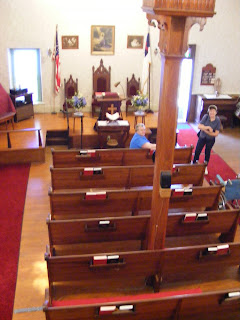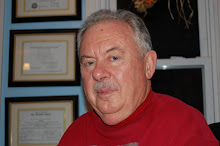 On Tuesday, June 10, 2008, Arletta and I went on a day long tour with George and June Crenshaw. June did the driving and George played the role of tour guide as we explored the history of this county. The Crenshaws live at the end of Tabor Valley Road in Wabaunsee County. They have been in the cattle business for many years. George is well known among cattlemen for his Black Angus cattle that were prize-winners at cattle shows. George and June are also well known as good neighbors in the community where they live.
On Tuesday, June 10, 2008, Arletta and I went on a day long tour with George and June Crenshaw. June did the driving and George played the role of tour guide as we explored the history of this county. The Crenshaws live at the end of Tabor Valley Road in Wabaunsee County. They have been in the cattle business for many years. George is well known among cattlemen for his Black Angus cattle that were prize-winners at cattle shows. George and June are also well known as good neighbors in the community where they live.The first picture is of the camels that reside at the Crenshaw Ranch. They belong to their son Roy who lives in a barn loft apartment next to the house.
The next picture is of the Beecher Bible and Rifle Church in Wabaunsee. The church was organize June 27-28, 1857 and built 1859-62. The original structure is of native stone. Several years ago repairs were made to the outside to fill cracks that had developed.
 The church still has services every Sunday with 10 to 30 people in attendance. The brochure for the church tells the story:
The church still has services every Sunday with 10 to 30 people in attendance. The brochure for the church tells the story:Until 1854, when Kansas was opened for settlement, the spot on which this old landmark church stands was just part of a vast ocean of tall prairie grass, under the ever-changing skies. To the north lay the Kaw River, crowding the bluffs beyond. A few miles to the east stood hills of spectacular beauty, and the prairie rolled gently away toward the south and the west. The silence was broken only by the winds or by the song of a meadow-lark, and at night the music of the prairie wolves. The land belonged to the Indians, the roving herds of buffalo and antelope, and the great flocks of migratory birds.
The Kansas-Nebraska bill, passed in May1854, changed all that forever. It provided that Kansas could become a free state or a slave state, depending on how the people of Kansas voted. The race was on to stake out claims and to vote Kansas "free" or "slave."
Two years later in 1856, there were already about 60 people living within a few miles of the place called Wabaunsee, which meant in Indian, "Dawn of Day." It was here on the south bank of the Kaw River that a settler built a tiny store. In New England, "Kansas Fever" ran high. The people of New Haven, Connecticut raised money to send a group of colonists to Kansas, sixty men led by one of New Haven's most respects citizens, Charles B. Lines. These were well educated men, many with professional training. They left behind good job and homes to move to Kansas. They were not just adventurers, with little to lose by going west; they were men who were making a sacrifice for their ideals.
Before the Connecticut-Kansas Company left for Kansas, a meeting was held in North Church in New Haven. Professor Silliman of Yale pledged $25.00 for Sharps rifle for the company. At the time the Sharps rifle was one of the best available. Henry Ward Beecher, for whom the church would be named, was a noted minister in Brooklyn, NY. Beecher himself never did come to Wabaunsee. He pledged that his congregation would give the money for 25 rifles if the audience would provide money for 25 more. Mr. Beecher sent Mr. Lines $625.00 for the rifles. With the money came 25 Bibles, the gift of a parishioner. The rifles were not smuggled into Kansas in a box marked "Bibles."
The Company left New Haven at midnight on March 31 after a torchlight parade across town to the steamboat to New York. The next day they were on a train to St. Louis, a very uncomfortable trip of three days. From St. Louis they sailed up the Missouri River on the steamboat Clara, as far as Kansas City. There they bought thirty wagons and sixty oxen along with farm implements, tents, and provisions for thirty days. They started west on the Oregon Trail (which closely parallels Highway 24) and stopped for a few days in the free town of Lawrence, Kansas. They continued then to Uniontown, near present day Williard. Here they crossed the Kaw River and continued west on the south side of the river. Soon they reached the place their scouts had selected--Wabaunsee, "The New Haven of the West."
By late April of 1856 Wabaunsee suddenly became a tent city. Streets were laid out and city lots and tracts of land were divided up among the men of the company. Some of them joined in worship that was held on Sundays, first in tents, later in cabins, or dugouts. The new settlers found life very difficult. Some became ill or discouraged and chose to return home. Those who remained until August were called to go to the defense of Lawrence. Organized as "The Prairie Guard," under their captain, William Mitchell, they spent six weeks fighting the border ruffians.
The winter of 1856-57 was one of great suffering in Wabausee. Things appeared more hopeful in the spring when wives and children came to join their husbands. Now that a permanent settlement seemed assured, there was also the desire for a permanent church location. In late June of 1857 fifteen of the members of the Colony and thirteen other settlers met to organize the "The First Church of Christ in Wabaunsee." The Rev. Harvey Jones was the first pastor. Of this group of 28 charter members, nine were women.
After two years of fund raising for a church building, primarily in New Haven, they started construction of the sturdy stone church that still stands in Wabaunsee. The stones were hauled from quarries on sledges drawn by oxen. The mortar was mixed by hand. The long shingles, called "shakes" were made with crude hand tools. The rows of straight backed pews were divided down the center of the church by a low wooden partition that separated the men from the women. From the balcony across the rear of the church a latter led to the belfry. The church yard was edged with hitching posts, and there were newly planted trees and lilacs in appropriate spots.
The new church was dedicated in May of 1862. By then many of the members had gone to fight in the Civil War. Soon there were only a few men and boys to carry on the work in Wabaunsee. After the war was over the town began to grow again. It never became the great city the people from New Haven envisioned, but the area grew into a thriving farm community. The church became the largest and most influential Congregational churches in Kansas. Only a few of the Connecticut families remained to raise their children in Kansas, but the few that remained became very influential in the community and the state.
The pioneers of Wabaunsee sent their children to Washburn College in Topeka or to Kansas State Agricultural College to become teachers, ministers, or missionaries. These young people went to faraway places to work, but never forgot Wabaunsee. When the church needed repairs they always gave generously to assist the Willing Workers Society. This group of church ladies who were forever busy with ice-cream socials or oyster suppers raising support for the minister or mortgage payments on the parsonage.
In 1907 old friends of the church came from far away to help celebrate the 50th anniversary of the First Church of Christ (Congregational) in Wabaunsee. Only two of the original company lived in Wabaunsee at the time, but they both played a large part in the Jubilee celebration.
In 1913 a renewal of interest developed in the church due to a new minister who came to start an experiment in rural development. The Rev. Anton Boisen organized people to build sidewalks, improve the church yar and the cemetery as well as to better their economic and social lives.
The population continued to dwindle. By the time the First World War ended they were no longer able to afford a resident minister. Now occasionally there would be guest ministers and occasional joint services with the Methodist church. An effort was made to merge the two churches but the project failed. Soon the little stone church was empty. The last entry in the record book was made in 1927.
The descendents of the "Beecher Colony" organized the "Old Settlers Association" in 1932. The last Sunday of August was designated "Old Settlers' Day." Throughout the years the "Old Settlers" gathered on this day and Decoration Day to reminisce and to honor men and women who had made the church a symbol of freedom around the world. Homecoming continues to be celebrated on the last Sunday in August.
The church and homes in the area were part of the Underground Railway to help slaves escape to the north. A home not far from the church had two hiding areas which would hold two people each for this very purpose.
 This picture shows one of the many stone buildings that were built in this area. Much of the stone for this barn was gathered from the nearby fields.
This picture shows one of the many stone buildings that were built in this area. Much of the stone for this barn was gathered from the nearby fields.In the late 1800s the government said it would pay 40 cents a rod for stone fences to be built. A rod is 16.5 feet in length. A hard working man might put up one or two rods a day.



No comments:
Post a Comment